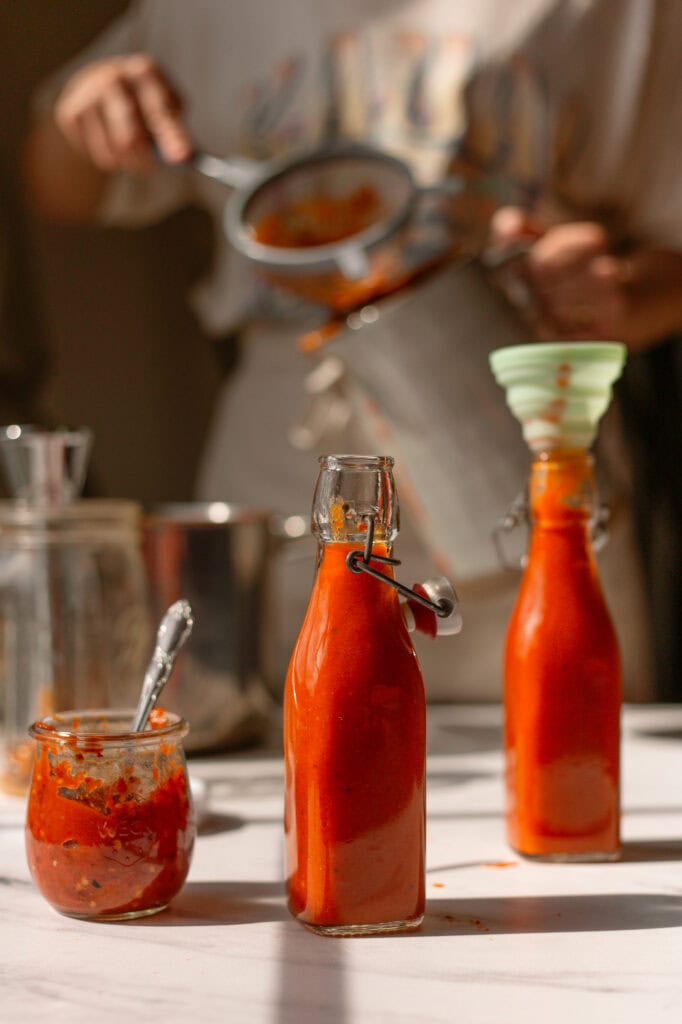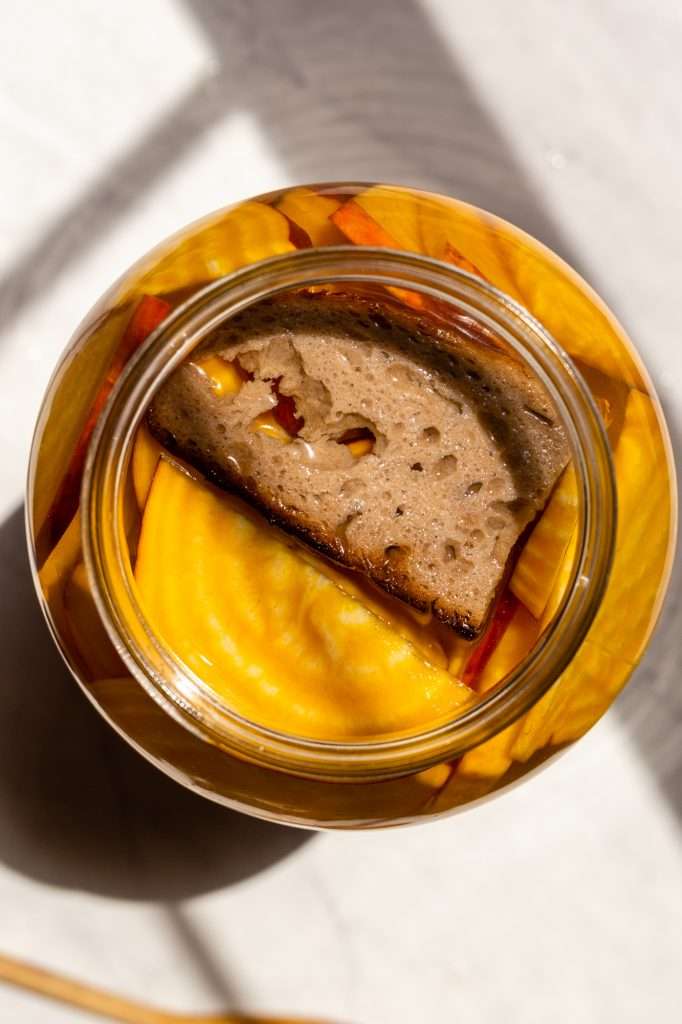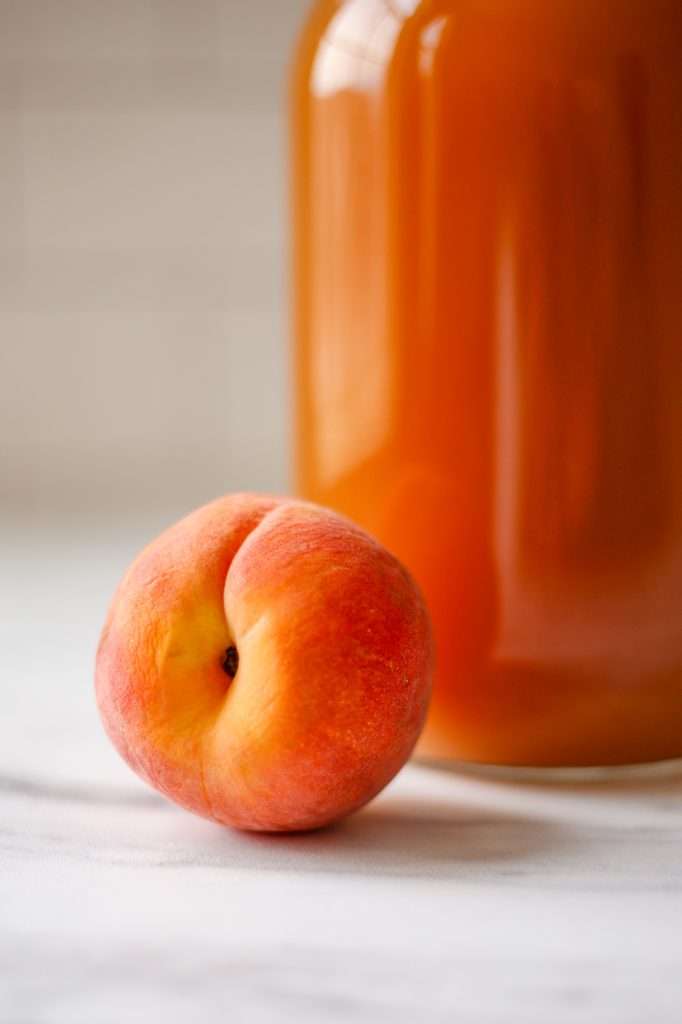Homemade Strawberry Cider
Is it strawberry cider or is it apple strawberry wine? In our blood orange cider recipe blog, I mentioned that cider must be 35% apple juice to be considered “cider.” Well, this recipe is mostly apple juice with some fresh strawberry syrup incorporated, so it’s totally considered a cider.
Another thing I’ve learned about cider is that the only difference between apple cider and apple wine is the alcohol content. If you brew some apple cider above 8.5% ABV, it is considered a wine, not a cider. So many rules.

This strawberry cider ends up around 9% ABV, so technically, it’s a wine. Call it cider or wine; it doesn’t matter to me.

Strawberry Hard Cider
My strawberry hard cider recipe produces light and fresh flavors that are perfect for spring! I like to bottle strawberry cider with honey to create a sparkling cider. However, it’s also fantastic as a still cider.
I love pairing this fresh fruit cider with our Sauerkraut Arugula Salad with Goat Cheese and Berries or Summer Lemon Kale Salad with Brined Salmon on hot summer days.

Strawberry Cider Recipe
I think brewing at home intimidates many people, so I made this recipe as easy as possible.
With this recipe, you can just buy some organic apple juice at the store. I used the 365 brand of organic pressed apple juice from Whole Foods. Make sure it is 100% apple juice and free from any preservatives and additives. Also, make sure the juice does not have any added sugar.
For the strawberry syrup, you will also need fresh strawberries, and organic berries work best. You can use frozen berries, but I love making this when fresh berries are in season in Louisiana.
Here are the ingredients you’ll need:
- 2 Grams Cider Yeast (Saccharomyces bayanus)
- Organic Pasteurized Apple Juice
- About a pound of organic strawberries
- Filtered Water
- Organic Cane Sugar

Cider Making Supplies
If this is your first time making cider at home, I highly suggest starting with this half-gallon recipe. This lets you get acquainted with the process and taste test before committing to a large batch.
Here is my Amazon list for brewing supplies. If you have a local home brew store, that is also an option to get what you need.
I got all my supplies at my local homebrew store up the street from my house. At a homebrew store, you can have someone help you pick out the right supplies.
- 1/2 gallon glass jug (with a cap)
- a second 1/2 gallon glass jug (with cap)
- 1 rubber stopper for brewing – You will need to make sure it is the right size for your jug. Some jugs have different diameter openings. I’ve linked the size stopper that fits my 1/2 gallon glass jug.
- an S airlock for the stopper
- a funnel
- large pot for boiling
- cheap vodka (for cleaning equipment)
- Two 1-Liter swing-top bottles (carbonation safe, for bottling the cider)

Choosing Yeast for Strawberry Cider
You can use champagne yeast or cider yeast for this recipe. If you visit a home-brew store, they should be able to help you select a cider yeast.
When buying packaged yeast, I like to make sure that the yeast species is not genetically modified. We chose to use Saccharomyces bayanus. This yeast species is associated with the natural fermentation of grapes, and it’s great for any fruit cider fermentation.
Another option is to use wild yeast. You only need about two tablespoons of wild yeast starter in place of the yeast in the recipe. Click here to learn how to make a wild yeast starter.

How to Bottle and Store Cider
Bottling and storing the cider is pretty straightforward. You need to verify that you have carbonation-safe bottles.
This is a sparkling hard cider so we will carbonate it. To carbonate hard cider in the bottle, we have to add a small amount of sugar, called priming sugar, right before bottling. I like to use honey as priming sugar because it contains a lot of fermentable fructans. More fructans = more bubbles.
The yeast will feed on the freshly added sugar and produce more carbon dioxide. Since the cider is in carbonation-safe bottles with the cap secure, the CO2 is forced into the cider and becomes carbonated. Bottling 1 liter with only one tablespoon of honey is not enough sugar to excessively carbonate. It’s just enough to produce a pleasant level of carbonation.
To make this a still cider instead of sparkling cider, do not add any honey or sugar when you bottle it.
You’ll need:
- Two 1-Liter Swing top bottles(Carbonation Safe)
- Organic Honey
How to Bottle
- Clean and sterilize the bottles.
- Add one tablespoon of honey to each 1 Liter bottle.
- Using a funnel, transfer the cider from the aging jug into the carbonation-safe bale top bottles, leaving the sediment in the bottom of the jug.
- Cap the bottles and invert gently twice to mix the honey with the cider.
- Allow to ferment at room temperature for five to seven days, then immediately place in the fridge. You can age the cider for 3 more weeks in the fridge before enjoying it chilled.

More Recipes to Try
- How to Make Sparkling Hard Apple Cider from Apple Juice
- Vinegar from Scratch
- Hard Blood Orange Cider Bottled with Honey

Hard Strawberry Cider Recipe Fermented With Fresh Berries
This hard strawberry cider recipe makes a delicious home-brewed fruit cider, perfect for spring and summer. You can bottle strawberry hard cider with honey for a refreshing sparkling cider.
- Prep: 30 minutes
- Cook: 30 minutes
- Total Time: 1009 hours
Ingredients
- 48 fl oz apple juice
- 16 fl oz filtered water
- 350 Grams strawberries
- 75 grams organic sugar
- 2 grams cider yeast
Instructions
- Clean and sanitize all of your equipment. I like to wash the jug with soap and water, allow it to air dry a bit, then rinse the jug with cheap vodka and allow it to air dry fully.
- Once your equipment is prepped, add the strawberries, water, and sugar to a pot, and bring to a simmer. Cook for about 15 minutes; while simmering, mash the strawberries a little with a spoon.
- Remove from heat and place a fine mesh colander over a pitcher or bowl; strain out the strawberry pulp and collect the liquid.
- Allow the strawberry liquid to cool, then, using a funnel, add it to the 1/2 gallon jug.
- Add in the cider yeast and mix gently by swirling. Wait about 30 minutes for the yeast to get frothy and active.
- In the meantime, heat the apple juice until simmering. Remove from heat and allow to cool to room temperature.
- Carefully using a funnel, add the apple juice to the jug leaving two inches of headspace (see pictures above).
- Cap the jug and swirl it around for about a minute.
- Remove the cap and place the airlock and stopper in the jug (see pictures above).
- After a few hours, you should notice a lot of bubbling in the cider and activity in the airlock.
- Allow the cider to ferment for 7 to 14 days until the bubbling completely stops, and you no longer see any activity in the airlock. At this point, you should see a lot of sediment in the bottom of the jug.
- Racking the cider: Remove the airlock and, using a funnel, transfer the cider to a new, clean jug for aging. Be careful pouring; pour gently and in one steady pour, leaving the sediment in the bottom of the original jug.
- Cap the jug with a regular lid. Allow the cider to age at a cool room temperature or in the fridge for four weeks.
- At this point, you can rack the cider again with more aging time or move on to bottling.
- To Bottle the cider with honey: Clean and sterilize two 1-liter carbonation-safe bottles. Add one tablespoon of honey to each 1-liter bottle. Transfer the cider from the aging jug into the carbonation-safe bottles using a funnel, leaving any sediment in the bottom of the jug. Cap the bottles and invert gently twice to mix the honey with the cider.
- Allow to ferment in the bottles at a cool room temperature for five days, then immediately store in the fridge. (check the carbonation by carefully opening a bottle over the sink, if it is not carbonated enough, you can leave it at room temperature for seven days.)
- You can age the cider for 3 more weeks in the fridge before enjoying it chilled. Keep refrigerated.
Notes
- You can use wild yeast in this recipe. You only need about two tablespoons of wild yeast starter in place of the yeast in the recipe. Click here to learn how to make a wild yeast starter.
- be sure to open the bottles to release the pressure occasionally when storing in the fridge for long periods. Don’t worry, though; Bottling 1 liter with only one tablespoon of honey is not enough sugar to excessively carbonate. It’s just enough to produce a pleasant level of carbonation.




















I just made this and am hoping it still turns out fine. I got to step 6 and got a little frustrated with the time allotment. It says:
“5. Add in the cider yeast and mix gently by swirling. Wait about 30 minutes for the yeast to get frothy and active.
6. In the meantime, heat the apple juice until simmering. Remove from heat and allow to cool to room temperature.”
I took that as— add the yeast, set my timer for 30 minutes, then start working on the apple juice. Well it definitely takes longer than 30 minutes for apple juice to heat up to a simmer and then cool back down to room temp. My yeast is going on over an hour in the jar now bubbling away lol. Meanwhile my juice is cooling in the freezer and I’m checking the temp constantly for at least 80-85 so I don’t just totally roast all my yeast lol
Will update with stars later but just thought I’d add this as a little warning for anyone else planning to make it soon. It looks like a wonderful recipe and I’ve very excited about it!
So sorry for the confusion; I thought “in the meantime” was clear, indicating to heat the apple juice while the waiting period in the previous step was being accomplished. I guess depending on what kind of stove you have, it can take a bit to heat and then cool. It’s totally fine if your yeast sat around frothy for longer than 30 minutes.
Is this still considered natural fermentation?
I’m on day 3 of fermenting and the color has changed from a nice red to a light orange. Is this normal or has the batch been contaminated?
completely normal! and what you should see. All ciders lighten in color to a golden or orangey hue during fermentation.
Hi, surely it’s ok to keep cider at cool room temp once it’s been bottled ? Or should you put less honey / primer to reduce risk of over carbonation?
Thanks 🙂
If you want to store it at room temperature, you must leave the priming sugar out entirely for safety, and bottle it as a still cider.
Can I use unpasteurized apple juice? Like if I would make apple juice from whole fresh picked apples or should I pasteurize it first?
Thanks!
yes, you can use fresh pressed apple juice. I suggest still following all the directions in the recipe with the fresh pressed juice. If you do not want to heat the apple juice though, it can still work, but you may find the final flavor more sour from possible wild fermentation (not a bad thing, just changes the flavor).
I live in the Caribbean and getting organic strawberries won’t happen and doubtful to get organic apple juice and sugar. Would I still be able to do this? And cider yeast? Amazon?
you should still be able to ferment this! I just write recipes with the specific ingredients I use. If you don’t use organic you may have different results.
This recipe was really fun to make and it came out tasting wonderful! Louisiana strawberries make everything better 🥰
Hi what are your thoughts an raspberry juice instead of strawberry??
sounds delicious! should work great!
Can i use the glass bottle i used to make Kombucha? Is there a different if i use this type of bottle?
Can I use honey instead of sugar for the bulk ferment?
yep! I use honey all the time with good results.